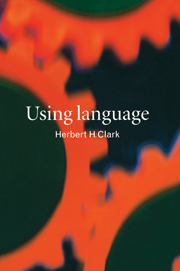11 - Conversation
Published online by Cambridge University Press: 05 June 2012
Summary
The fundamental site for language use is conversation, spontaneous dialogue among two or more people. Although conversations are created from utterances, they are more than the sum of their parts. Let us return to the telephone conversation discussed in Chapter 7(8.11.851):
Jane: (rings C's telephone)
Kate: Miss Pink's office – hello
Jane: hello, is Miss Pink in.
Kate: well, she's in, but she's engaged at the moment, who is it?
Jane: oh it's Professor Worth's secretary, from Pan-American College
Kate: m,
Jane: could you give her a message *forme*
Kate: *certainly*
Jane: u:m Professor Worth said that, if. Miss Pink runs into difficulties,. on Monday afternoon,. with the standing subcommittee,. over the item on Miss Panoff, —
Kate: Miss Panoff?
Jane: yes ,that Professor Worth would bewith Mr Milesall afternoon, – so she only had to go round and collect him if she needed him, —
Kate: ah, — thankyou very much indeed,
Jane: right
Kate: Panoff, right *you* are
Jane: *right,*
Kate: I'll tell her, *(2 to 3 syllables)*
Jane: *thankyou*
Kate: bye bye
Jane: bye
Here Jane and Kate complete one main task, passing a message from Professor Worth to Miss Pink. They do this through a series of smaller sections – opening the conversation, exchanging information about Pink, exchanging the message from Worth, and closing the conversation. They complete each section by means of adjacency pairs (e.g., questions and answers), and complete each adjacency pair turn by turn. Viewed as a whole, the conversation consists of a hierarchy of parts: conversation, sections, adjacency pairs, and turns.
Information
- Type
- Chapter
- Information
- Using Language , pp. 318 - 352Publisher: Cambridge University PressPrint publication year: 1996
Accessibility standard: Unknown
Why this information is here
This section outlines the accessibility features of this content - including support for screen readers, full keyboard navigation and high-contrast display options. This may not be relevant for you.Accessibility Information
- 1
- Cited by
